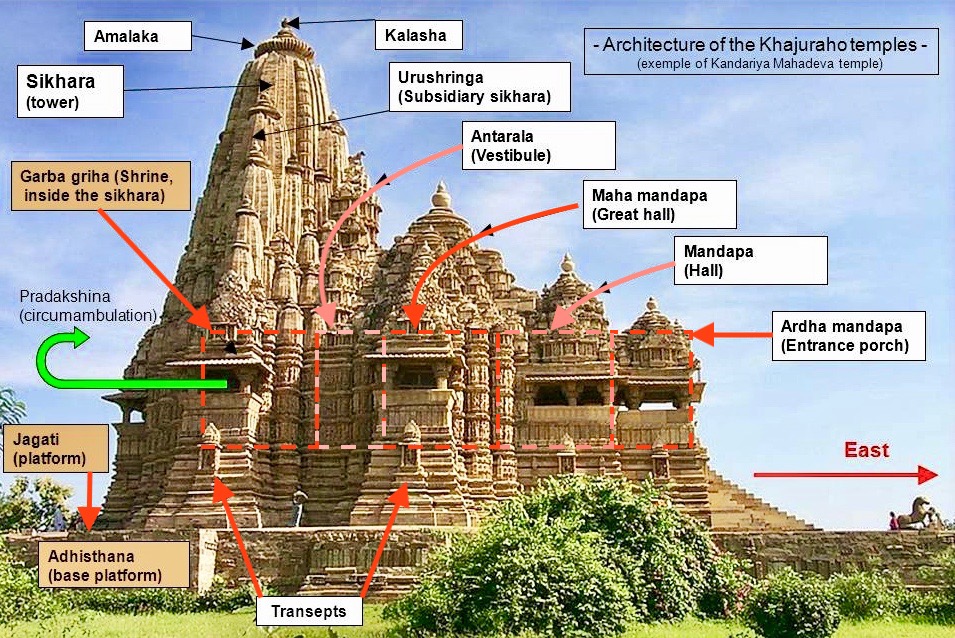- Home
- Prelims
- Mains
- Current Affairs
- Study Materials
- Test Series
Khajuraho Temples
- The Khajuraho Temples or Khajuraho Group of Monuments are a group of Hindu and Jain temples in Chhatarpur district, Madhya Pradesh, India.
- These are located in the Vindhya Mountain range.
- The Temples of Khajuraho are a magnificent example of the Nagara style of temples as the temples consist of
- a sanctum,
- a narrow ante-chamber (antarala),
- a transept (mahamandapa),
- additional halls (ardha mandapa),
- a mandapa or nave and
- an ambulatory passage (Pradakshina-path) which is lighted by large windows.
- Most Khajuraho temples were built between 885 CE and 1000 CE by the Chandela dynasty.
- Historical records note that the Khajuraho temple site had 85 temples by the 12th century, spread over 20 square kilometres (7.7 sq mi).
- Of these, only about 25 temples have survived, spread over six square kilometres (2.3 sq mi).
- Of the surviving temples, the Kandariya Mahadeva Temple is decorated with a profusion of sculptures with intricate details, symbolism, and expressiveness of ancient Indian art.
- The Khajuraho group of temples were built together but were dedicated to two religions, Hinduism and Jainism, suggesting a tradition of acceptance and respect for diverse religious views among Hindus and Jains in the region.
- The largest surviving Shiva temple is Khandarya Mahadeva, while the largest surviving Vaishnava group includes Chaturbhuja and Ramachandra.
- Because of their outstanding architecture, diversity of temple forms, and testimony to the Chandela civilization, the monuments at Khajuraho were inscribed on the UNESCO World Heritage List in 1986.
- In each group of Khajuraho temples, there were major temples surrounded by smaller temples – a grid style that is observed to varying degrees in Hindu temples in Angkor Wat, Parambaran and South India.
- The 10th-century Bhand Deva Temple in Rajasthan was built in the style of the Khajuraho monuments and is often referred to as ‘Little Khajuraho’.
- Erotic imagery is very common in the Temples of Khajuraho.
- Sculptures of celestial nymphs with broad hips, heavy breasts and languishing eyes are commonly found in the Kandariya Mahadeva and Vishwanath Temple. These sculptures are believed to reflect the idea of female beauty and fertility.
- Other scenes depicted on the walls of the temples are a part of the Narathara (the human life cycle) signifying how sexual procreation and kamaare an essential aspect of human life.
- The major focus of the study of the Temples of Khajuraho have been on the sculptures.
- The walls of these temples have some of the best sculptures of the time, making Khajuraho a representation of excellent artistic features.

- It is believed that the temples constitute five different sets of sculptures:
- cult images
- the parivara, parsva and avarana devatas
- the apsaras and the surasundaris
- secular sculptures of miscellaneous themes (dancers, musicians, disciples and domestic scenes)
- mythical creatures (vyalas, sardula and other animals)
- The first mention of Khajuraho and its temples is in the accounts of Abu Rahyan al Biruni (1022 CE) and Ibn Batuta (1335 CE).
- The carvings on them reflect the four goals of life in Hinduism, viz, dharma, kama, artha, moksha.
- One theory posits their construction can be understood as a part of the proliferation of the Siva-Sakti cult. The other theory is that the temples are a representation of the devadasis who were once a major part of the temple activities.
- The Temples of Khajuraho are divided into three groups, the Western Group, the Eastern Group and the Southern Group.
The Western Group:
- Chausath Jogini Temple-this temple stands on the low rocky eminence to the south west of the Sib-Sagar
- Kandariya Mahadeva Temple– Largest of all the temples in Khajuraho, it dates back to the 10th century CE.
- Devi Jagdamba Temple -this temple is now known by the name of Devi Jagdamba or the ‘Mother Goddess of the World’.
- Chitragupta or Bharatji’s Temple -This temple is dedicated to the Sun God (Surya), an image of the Sun God is enshrined within the sanctum, wearing high boots and driving a chariot of seven horses.
- Vishwanath Temple – Vishwanath, or the ‘Lord of the Universe’, is another name for Lord Shiva to whom this temple is dedicated.
- Laxmana Temple -also known as the Chaturbhuj Temple.
- It is popularly known for its innovation in the technique of architecture.
The Eastern Group:
- Brahma Temple -situated on the banks of Khajuraho Sagar.
- Vamana Temple -situated on the north-east side of the Brahma Temple
- Ghantai Temple -this temple got its name from the bells suspended on chains which adorn the pillars of its portico.
- Parsawanatha Jain Temple – it is the largest of the Jaina temples. It is believed to be a shrine of Parsawanatha, the 22nd Jain Tirthankara.
The Southern Group:
- Duladeo Temple – It is about a mile and a half away from the main Khajuraho Temples and was originally dedicated to the Siva
- Jatkari or Chaturbhuja Temple -situated near the Jatkari village, this temple faces west. It is dedicated to Lord Vishnu.
Khajuraho Temples, Religious affiliations and Consecration Years
|
Modern temple name |
Religion |
Deity |
Completed by (CE) |
|
Chausath Yogini |
Hinduism |
Devi, 64 Yoginis |
885 |
|
Lalguan Mahadev |
Hinduism |
Shiva |
900 |
|
Brahma Temple |
Hinduism |
Shiva |
925 |
|
Lakshmana |
Hinduism |
Vaikuntha Vishnu |
939 |
|
Varaha |
Hinduism |
Varaha |
950 |
|
Parshvanatha |
Jainism |
Parshvanatha |
954 |
|
Ghantai |
Jainism |
Adinatha |
960 |
|
Mahishasuramardini |
Hinduism |
Parvati |
995 |
|
Vishvanatha |
Hinduism |
Shiva |
999 |
|
Matangeshwar |
Hinduism |
Shiva |
1000 |
|
Vishnu-Garuda |
Hinduism |
Vishnu |
1000 |
|
Beejamandal Temple ruins |
Hinduism |
Shiva |
1000 |
|
Ganesha |
Hinduism |
Shiva |
1000 |
|
Jagadambi |
Hinduism |
Devi Jagadambi |
1023 |
|
Chitragupta |
Hinduism |
Shiva |
1023 |
|
Adinath Temple |
Jainism |
Adinatha |
1027 |
|
Shantinatha temple |
Jainism |
Shantinatha |
1027 |
|
Kandariya Mahadeva (the largest temple) |
Hinduism |
Shiva |
1029 |
|
Vamana |
Hinduism |
Vamana |
1062 |
|
Javeri |
Hinduism |
Shiva |
1090 |
|
Chaturbhuja |
Hinduism |
Vishnu |
1110 |
|
Duladeo (Duladeva) |
Hinduism |
Shiva |
1125 |









 Latest News
Latest News
 General Studies
General Studies